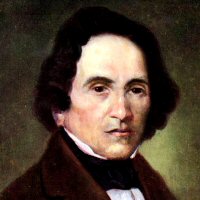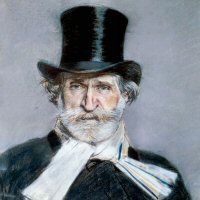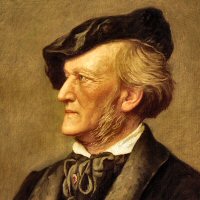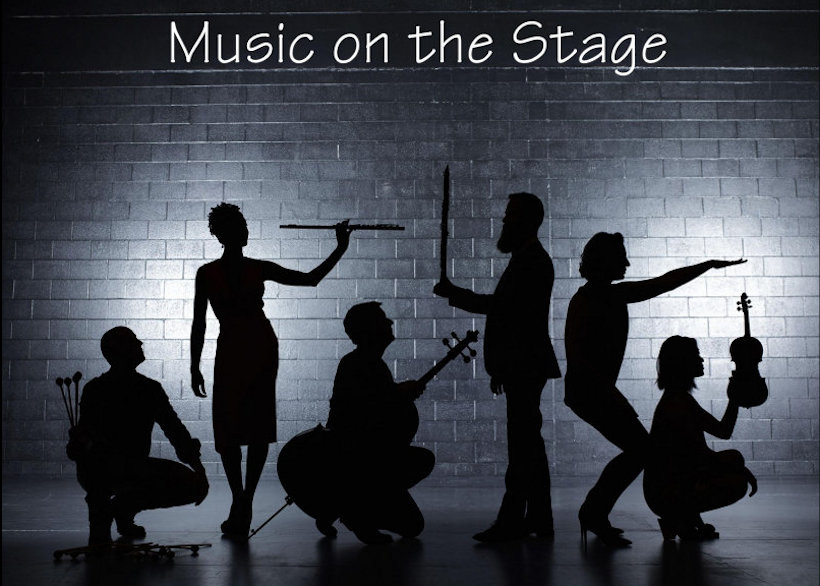7. An Extravagant Art.
By 1830, Paris had become the opera capital of the world, largely through the ability of its theaters to mount
productions with striking scenic effects, and provide the large orchestras, choruses, and ballets required to put
on an impressive show. The form that emerged, grand opéra, was largely the creation of one man, Giacomo Meyerbeer
(1791–1864), yet his example immediately attracted similar works by Rossini, Donizetti, and others, and would have
a lasting influence on Verdi, Wagner, and opera in general through the end of the century.
The first hour will consist of an overview of Meyerbeer’s masterpiece, Les Huguenots (1836), which happens to
be the one opera of the period available in a production that comes close to the original in style. In the second hour,
we look at two characteristic aspects of grand opéra—ballet and pageantry—to see how they surfaced again in operas by
Wagner and Verdi, and how they are treated by modern directors working in an era when stylistic expectations have
changed so completely! rb.
The script, videos, and images will be posted immediately after class.
Most of the clips shown in class are availble on YouTube, though not always with titles or in high quality. The
Huguenots is the full opera, cued to the points we picked it up in class. The dance clips from Stefan
Herheim's Vêpres siciliennes that I showed are not available, but I do include the ballet documentary that
I mentioned, and the full version of the boléro from the final act. The Aïda productions from Bregenz
and Paris are available as trailers only, although here again I include the very interesting interview with the Paris
director, Robert Carsen.
| GIACOMO MEYERBEER |
| |
Les Huguenots |
|
Act III opening
(Opera Australia)
Act IV conspirators' scene
Act IV duet
Act V trio and ending
|
| |
| RICHARD WAGNER |
| |
Tannhäuser |
|
Entrance of the guests, Act II (1845)
Bacchanal, Act I (Paris revision, 1865)
|
| |
| GIUSEPPE VERDI |
| |
Les vêpres siciliennes |
|
Act III ballet, ending
(La Scala)
Stefan Herheim on the 2013 London production
Act V Boléro
(London, 2013)
|
| |
Aïda |
|
Act II, scene 1, ballet
(Metropolitan Opera)
Act II, scene 2, opening
(as above)
Act II, scene 2, opening
(Barcelona)
Act II, scene 2, march and ballet
(as above)
Verona production, 2023, ballet
Bregenz production, 2009, trailer
Paris production, 2021, trailer
— documentary on this production
London production, 2022, opening
— documentary on this production
|
| |
|
|
|
|
|
| IMAGES |
The thumbnails below cover the slides shown in class, though
there may be a few small discrepancies. Click the thumbnail to see a larger image.
Click on the right
or left of the larger picture to go forward or back, or outside it to close. |
 | |
 | |
 | |
 | |
 | |
 | |
 | |
 | |
 | |
 | |
 | |
 | |
 | |
 | |
 | |
 | |
 | |
 | |
 | |
 | |
 | |
Here are brief bios of the artists, composers, and writers considered in the class, listed in order of birth.
 |
Giacomo Meyerbeer, 1791–1864. German composer working in France.
Although born and trained in Germany, Meyerbeer began his prolific opera career in Italy, falling under the spell of the serious operas of Rossini. He moved to Paris in 1826 and began a series of operas that essentially defined the notion of Grand Opera, among them Robert le Diable (1831), Les Huguenots (1836), Le Prophète (1849), and L'Africaine (1865).
|
 |
Giuseppe Verdi, 1813–1901. Italian opera composer.
Verdi's two dozen or more operas (depending on how you count them) make him the leading Italian opera composer of his time and among the two or three greatest opera composers ever. After what he called his "years in the galleys," he hit his stride in the early 1850s with the trio of Rigoletto, Il Trovatore, and La Traviata. He intended Aïda (1870) to be his last work, but was persuaded out of retirement to write his final Shakespearean masterpieces: Otello (1886) and Falstaff (1893).
|
 |
Richard Wagner, 1813–83. German opera composer.
Wagner almost single-handedly transformed the nature not only of opera but also of harmony and orchestration. His 10 mature operas include Tristan und Isolde (1865), Die Meistersinger von Nürnberg (1868), and the vast tetralogy Der Ring des Nibelungen (completed 1876), for which he had a special theater built at Bayreuth. His final opera, Parsifal (1882), was written for exclusive performance at that theater.
|
























